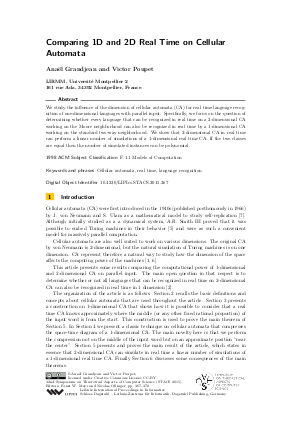Comparing 1D and 2D Real Time on Cellular Automata
Authors Anaël Grandjean, Victor Poupet
-
Part of:
Volume:
32nd International Symposium on Theoretical Aspects of Computer Science (STACS 2015)
Part of: Series: Leibniz International Proceedings in Informatics (LIPIcs)
Part of: Conference: Symposium on Theoretical Aspects of Computer Science (STACS) - License:
 Creative Commons Attribution 3.0 Unported license
Creative Commons Attribution 3.0 Unported license
- Publication Date: 2015-02-26
File

PDF
LIPIcs.STACS.2015.367.pdf
- Filesize: 3.03 MB
- 12 pages
Document Identifiers
Subject Classification
Keywords
- Cellular automata
- real time
- language recognition
Metrics
- Access Statistics
-
Total Accesses (updated on a weekly basis)
0PDF Downloads0Metadata Views
Abstract
We study the influence of the dimension of cellular automata (CA) for real time language recognition of one-dimensional languages with parallel input. Specifically, we focus on the question of determining whether every language that can be recognized in real time on a 2-dimensional CA working on the Moore neighborhood can also be recognized in real time by a 1-dimensional CA working on the standard two-way neighborhood. We show that 2-dimensional CA in real time can perform a linear number of simulations of a 1-dimensional real time CA. If the two classes are equal then the number of simulated instances can be polynomial.
Cite As Get BibTex
Anaël Grandjean and Victor Poupet. Comparing 1D and 2D Real Time on Cellular Automata. In 32nd International Symposium on Theoretical Aspects of Computer Science (STACS 2015). Leibniz International Proceedings in Informatics (LIPIcs), Volume 30, pp. 367-378, Schloss Dagstuhl – Leibniz-Zentrum für Informatik (2015)
https://doi.org/10.4230/LIPIcs.STACS.2015.367
BibTex
@InProceedings{grandjean_et_al:LIPIcs.STACS.2015.367,
author = {Grandjean, Ana\"{e}l and Poupet, Victor},
title = {{Comparing 1D and 2D Real Time on Cellular Automata}},
booktitle = {32nd International Symposium on Theoretical Aspects of Computer Science (STACS 2015)},
pages = {367--378},
series = {Leibniz International Proceedings in Informatics (LIPIcs)},
ISBN = {978-3-939897-78-1},
ISSN = {1868-8969},
year = {2015},
volume = {30},
editor = {Mayr, Ernst W. and Ollinger, Nicolas},
publisher = {Schloss Dagstuhl -- Leibniz-Zentrum f{\"u}r Informatik},
address = {Dagstuhl, Germany},
URL = {https://drops.dagstuhl.de/entities/document/10.4230/LIPIcs.STACS.2015.367},
URN = {urn:nbn:de:0030-drops-49275},
doi = {10.4230/LIPIcs.STACS.2015.367},
annote = {Keywords: Cellular automata, real time, language recognition}
}
Author Details
References
-
Stephen N. Cole. Real-time computation by n-dimensional iterative arrays of finite-state machines. IEEE Transactions on Computers, C-18(4):349-365, 1969.

-
Marianne Delorme, Enrico Formenti, and Jacques Mazoyer. Open problems on cellular automata. Technical report, LIP - ENS Lyon, 2000.

-
Oscar H. Ibarra and Tao Jiang. Relating the power of cellular arrays to their closure properties. Theoretical Computer Science, 57(2-3):225-238, 1988.

-
Jacques Mazoyer and Nicolas Reimen. A linear speed-up theorem for cellular automata. Theor. Comput. Sci., 101(1):59-98, 1992.

-
Alvy R. Smith III. Simple computation-universal cellular spaces. J. ACM, 18(3):339-353, 1971.

-
Véronique Terrier. Low complexity classes of multidimensional cellular automata. Theor. Comput. Sci., 369(1-3):142-156, 2006.

-
John von Neumann. Theory of Self-Reproducing Automata. University of Illinois Press, Urbana, IL, USA, 1966.

